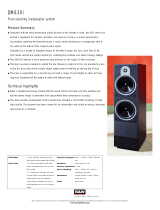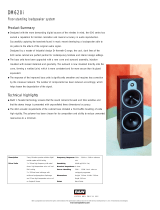
Copyright © 1991-1997 by Linn Products Limited. All Rights Reserved.
Page 5
Revised Dec 97
Index
GENERAL INFORMATION
This will give some general information on the faults , (and abuse!) of speaker units.
The most common cause of failure is over-driving which may result in:
Distorted sound,
Low output,
And finally:No Sound
All faults can normally be confirmed by opening up the unit and examining the voice
coil. Be warned that once a unit is opened it can not be reused and will have
to be replaced, so only do this if the unit is confirmed as being faulty.
DAMAGED UNITS
1. CURRENT OVERDRIVE: (All units)
When playing the music too loud (parties etc) or when driving a low powered
amplifier into clipping the current across the voice coil can become excessive
and cause the speaker voice coil to overheat.
First:
The enamel on the coil will start to blister and swell and this will cause
distortion as it will touch and rub the sides of the magnet gap as the voice
coil moves forward and backward.
Next:
If the condition that is causing the blistering to occur continues, (the volume
is not turned down) the blistering will increase until it is large enough to restrict
or stop the voice coil moving This will result in increased distortion, reduced
output and finally - no sound.
This can be seen by opening up the speaker and examining the voice
coil.
Remember, opening the unit is final and not reversible so the unit will
be need to be scrapped.
Finally:
The voice coil wire burns out and either goes open or short circuit. The unit
is now dead. This can be confirmed by checking with a multi-meter set on
ohms: Typical reading for a good unit is around 6- 8 Ohms.
2. HIGH FREQUENCY OSCILLATION: (Treble units)
This can occur with unstable or faulty amplifiers which generate high frequency
signals (which may sometimes only be audible to the neighbourhood cat)
which will cause the unit to overheat due to the excessive High Frequency
current. - see point 1. These H/F signals can also occur where there are
earthing problems. Some named amplifiers go nuts should you disconnect the
earth while the volume is up, especially phono earths.
3. TRANSIENT DAMAGE: (Treble units)
This can happen when a large transient signal is applied to the speaker such
as letting the stylus fall on the record with the volume set very high, fast cuing
(fast fwd or fast rev)of a tape recorder with the volume set high etc.
This will cause the voice coil to "leap" forward (or backword) beyond the limit
of its normal travel which may break the voice coil lead wire at the start of the
coil.
4. DC VOLTAGE ACROSS THE SPEAKER. (Bass and Mid-range units)
Should a power amplifier become faulty and produce DC across the speaker
output the voice coil(s) will overheat and become damaged or destroyed (See
1). However as the treble units in passive speakers are driven through a by-
pass filter they will not be damaged unless the voltage is sufficient to burn out
the crossover, after which all the units may be destroyed.
SPEAKER UNITS
























